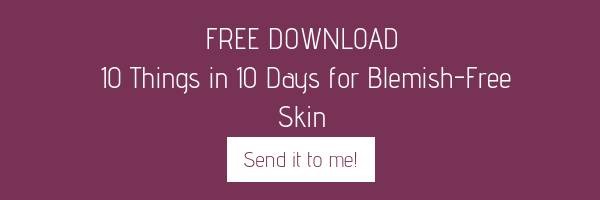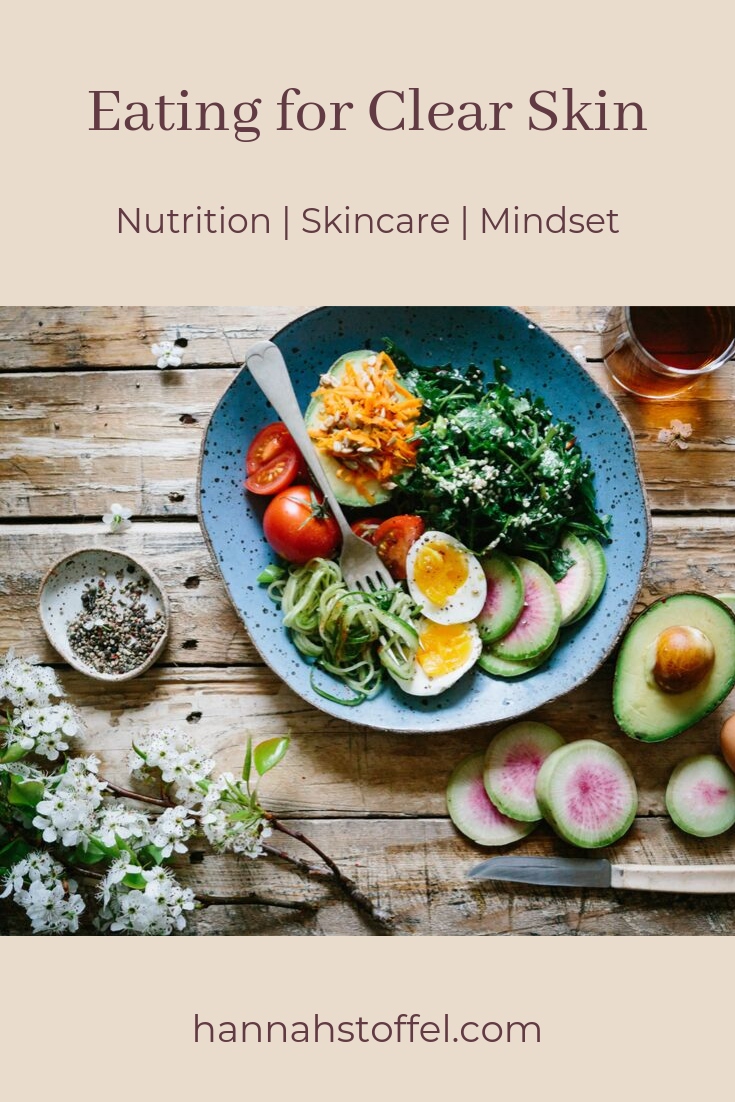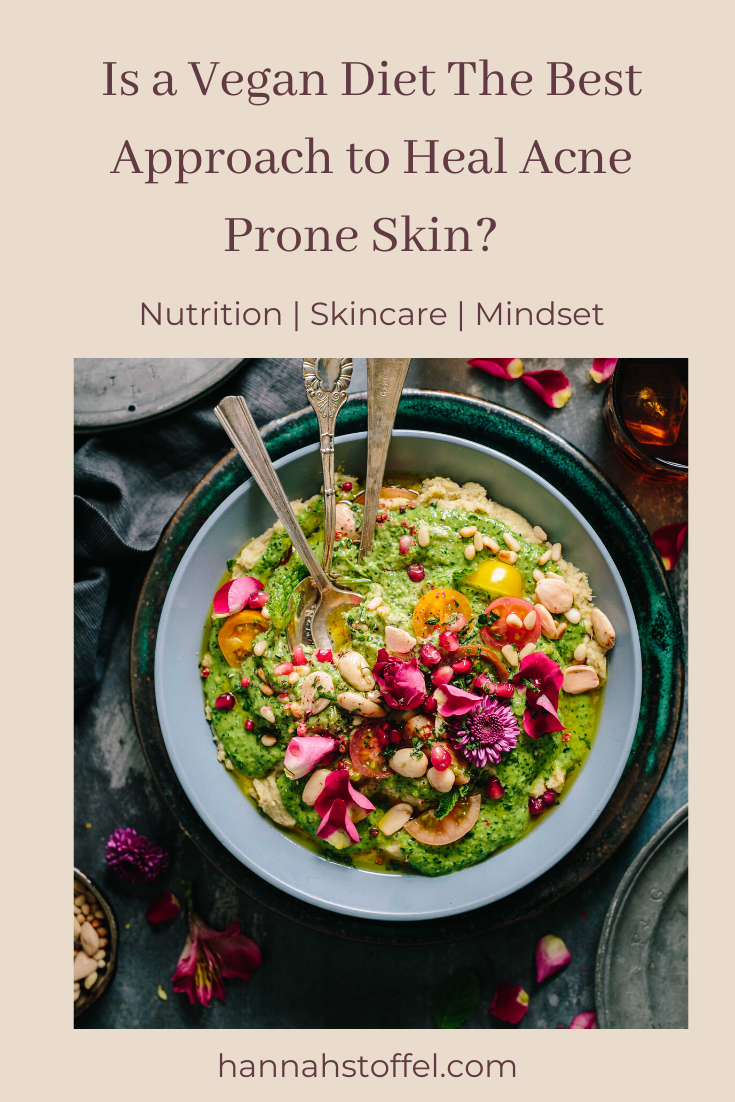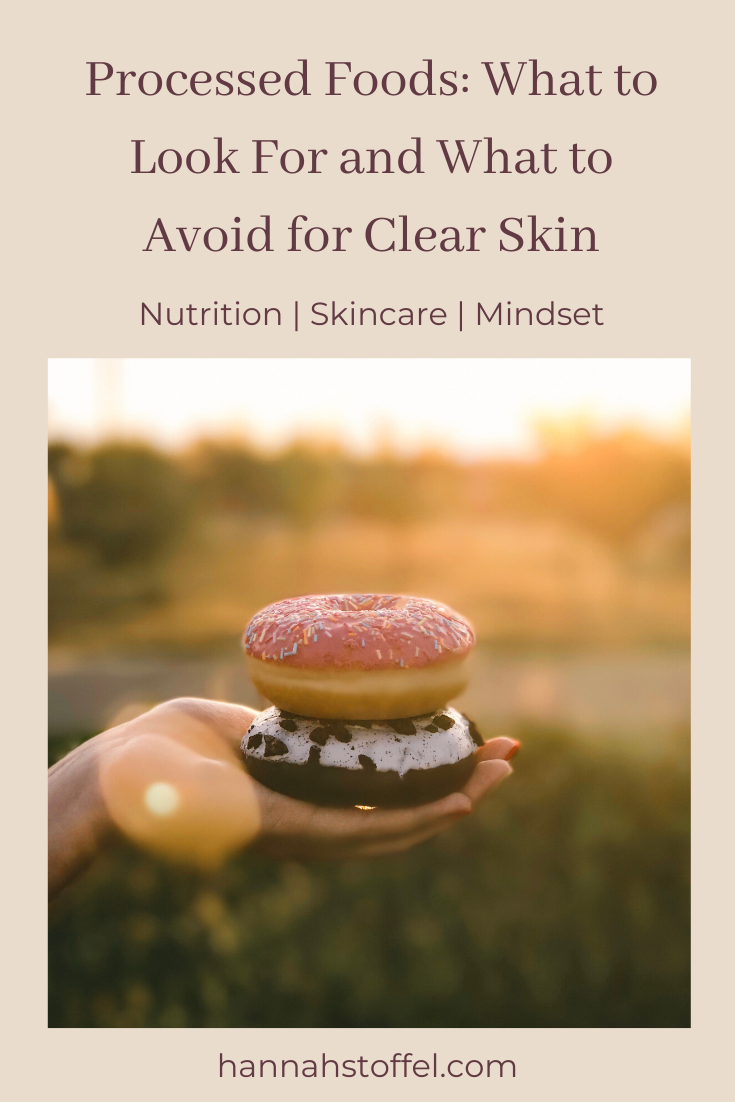December 13, 2017
When it comes to healing acne with nutrition, there is a lot of talk about what you can no longer eat.
The first things to leave your diet are gluten, dairy, processed foods and refined sugar. To a lot of women that is a bit overwhelming. However, it is true that these foods are inflammatory in the body, especially when eaten in excess, which we tend to do.
While it's important to reduce our intake of inflammatory foods, it is
equally as important to increase our intake of foods that reduce inflammation and are full of antioxidants.
When I first began changing the way I ate to heal my skin, I almost fell into a state of depression around food. I knew the foods I shouldn't be consuming, but I didn't yet have a strong taste for the foods I needed to be eating. I longed for the comfort foods I grew up with. Because of this I oftentimes felt hungry, but didn't feel like eating.

This struggle left my body lacking a great deal of nutrition. In fact, my body was so nutrient deficient that my hair started falling out. Hair may be our crowning glory, but our bodies don't recognize it as being necessary for survival. Therefore, it's a go to place for the body to stop sending nutrients when necessary. It wasn't until I visited a naturopath
(although not before I ended up with a bald spot on the side of my head) who informed me that I simply wasn't nourishing my body well.

The amazing thing about your body is you can teach it what foods you want it to crave!
The concept is simple. Feed your body the foods it should be having and thanks to metabolic reprogramming you'll be craving those foods in about 30 to 90 days. So cool, right? The old adage, 'you are what you eat' is correct. Your cells are literally made up of what you feed them!
Now that you know, the next step involves making a decision: Keep doing what you're doing while getting the same results or change the way you eat and possibly get better results.
If you're ready to start making some changes I encourage you to take small steps. Don't go buy a ton of produce you've never cooked with before. Start with the fruits and vegetables you know and are comfortable with. Find a few recipes that suit your tastes and build from there. I often eat the same few dishes for several weeks before I tire of it and find something different to add in the mix. I recommend you do the same.
- Lemons. Lemons are one of the most cleansing, detoxifying foods. Juice from a fresh squeezed lemon provides support to the liver and and aids digestion. The liver is a our main detoxifying organ, so it's vital to support it in order to clear up acne. Enjoying fresh squeezed lemon in your water throughout the day is one of the simplest ways to do this.
- Turmeric. This Indian spice is anti-inflammatory and anti-coagulant. It keeps red blood cells from clumping and increases circulation. Better blood flow is vital to keep the skin glowing. Turmeric acts as a blood cleanser which helps prevent acne. I find you can add a dash of this to oatmeal or Juice Plus Complete. You can learn more about that here. By also adding nutmeg and cinnamon you won't taste the turmeric.
- Arugula. Arugula is high in vitamin A, which may not only improve acne but also helps protect the skin from free radical damage. This dark leafy green is alkaline and will help cleanse the blood and lymphatic system. Arugula does have a strong flavor and is a bit peppery. I prefer to mix it with a portion of organic spring mix, which contains baby lettuces and spinach. It helps balance the flavor.
- Bell Peppers. Bell peppers are a wonderful beauty food. One of the simplest ways to consume them is chopped in a salad. Red bell peppers are particularly high in vitamin C. Not only is this beneficial to help banish acne, but it also helps regenerate collagen in the skin which may slow down the aging process. I do recommend you opt for organic with bell peppers as they are one of the more heavily pesticide laden foods.
- Onions. Onions are an amazing food. Not only do they add great flavor to many dishes, they also contain properties that help cleanse the liver which is crucial for the health of our skin. It's beneficial to eat this food both cooked and raw. The two onion varieties I use most often and that contain the most health benefits are yellow onions and red onions. Yellow onions have the most sulfuric compounds while red onions are high in antioxidants, which we can see from its bright purple color. Here is a great article on the best way to store onions https://draxe.com/onion-nutrition
- Garlic. Garlic helps support your body's detoxification system and may aid in digestion; two things necessary for clearer skin. Garlic contains an enzyme called alliinase and a sulfur-containing substance called allicin. Pressing garlic activates the release of the these anti-inflammatory substances. In the store you'll see containers of pre-chopped garlic for sale. I recommend you opt for purchasing the whole garlic (bulk garlic) instead. Not only is it more cost effective, but also so much of the health benefits happen when pressing the garlic and then fade away shortly thereafter. Buying pre-chopped garlic isn't going to give you the same anti-inflammatory effects.
- Wild Caught Alaskan Salmon. Salmon is so beneficial for the health of our skin and it is a large reason why I don't advocate for a strict vegan diet. I dedicated an entire blog post to this amazing fish. You can read that blog post here.

Remember, when it comes to clearing your skin, changes probably won't happen overnight. A large component is restoring your internal health and those changes are then reflected in your skin. Opt for whole foods whenever possible and you'll begin to see positive improvements.
I am an independent distributor for the Juice Plus Company ®. I have included links to my Juice Plus website. By purchasing through this link I receive a small commission. Purchases are not necessary but are greatly appreciated and help me continue to deliver quality content for free!
Posted in Acne. Tagged as acne, acne coach, acne scars, acne treatment, clear skin, clear skin diet, health and wellness, health coach, hormonal acne, how to heal acne, nutrition for acne, what to eat to heal acne.
November 29, 2017
When I first wanted to heal my acne through nutrition, Google became my best friend. I honestly didn't know much about nutrition, and I definitely didn't understand how food affects our body and our skin. One of the first concepts I encountered while researching adult female acne was a vegan diet.
 While the cystic acne on my face was at it's height in severity, I went vegan for many months. In the beginning I did notice some improvement in the appearance of my skin. However, in the end being vegan didn't win out for me.
While the cystic acne on my face was at it's height in severity, I went vegan for many months. In the beginning I did notice some improvement in the appearance of my skin. However, in the end being vegan didn't win out for me.
While my diet is still largely plant based, I don't eliminate all animal products. I want to share with you my thoughts on the vegan diet, specifically as it relates to acne.
 The benefits of a vegan diet can be
The benefits of a vegan diet can be the large number of plants consumed. When you're not consuming animal protein, you need more fruits and vegetables to fill you up. Fruits and vegetables contain antioxidants which help fight inflammation in the body.
Acne can be an indication of excess inflammation in the body so, logically, it makes sense to consume more fruits and vegetables. The problem that often arises here, and the reason I put can be in italics, it's easy to be vegan and lose sight of nutrition.
It's easy to become so focused on whether a not a food is vegan that you forget to evaluate nutritional value. Technically, Oreo's® are vegan. Although I don't think anyone would argue that eating these cookies will help clear your skin. I've seen many times, including in myself, where consuming a vegan diet quickly turns to lots of vegan baked goods, pastas and baked potatoes. These things are fine in moderation but they aren't the super-foods needed to boost our immune system so you can give acne a kiss good-bye.
The downside to a vegan diet is its neglect of healthy fats. When researching a vegan diet I was quite alarmed at how many proponents of this diet still had the low fat mentality that plagued the 90's. The concept of following a low fat/no fat diet is outdated information that was never actually correct. In fact, during the 90's when the low fat craze really took off, heart disease increased as people's waist lines grew. Why did this happen? Most likely it was due to high insulin levels. Instead of eating healthy fats, which keep you fuller, longer, people were eating low- fat crackers, highly refined pastas and low- fat yogurts. All these things spike our insulin levels which leads to excess belly fat, AND many people felt constantly hungry because the very thing that helps keep us full fat was removed from food. What I'm discussing here pertains to weight gain and heart health but, please make no mistake, it's also connected to the appearance of your skin. Warning signs of internal excess inflammation in the body, such as acne, should help us connect the dots: a low-fat/no fat diet won't give us the skin, or the overall health we want.
Vegan diets also eliminate the intake of wild-caught, sockeye salmon. I really can't overstate its benefits to our skin health. First, wild-caught salmon provides a hefty dose of omega-3 essential fatty acids. Essential fatty acids simply means our bodies don't make these fats, therefore, we must get them from food. Omega-6's are also essential fatty acids. However, because of deficiencies in our food supply these days (such as eating grain-fed instead of grass-fed beef, or consuming processed foods containing unhealthy, shelf-stable oils) we are ingesting too much omega-6's and not enough omega-3's. The ratio of these oils should be 1:2 omega 3 omega 6. Unfortunately, our modern diets tend to have a ratio of 1:10 of omega-3 (anti-inflammatory) to omega-6 (inflammatory). [William Sears, MD, The Inflammation Solution,©2015]
Vegan diets also lack astaxanthin. Here we go again with salmon the prize winning fish! Astaxanthin is another reason to love this fish. Astaxanthin gives salmon its beautiful pink color. It's a nutrient that has a powerful anti-inflammatory effect. Astaxanthin paired with beneficial omega-3's in wild-caught salmon make this fish vital to our diets. Notice I keep emphasizing wild-caught. It is important that you avoid purchasing farm-raised salmon. It doesn't contain the same amounts of the powerful antioxidants. In fact, farm-raised salmon may have pink color added, so it appears more like wild-caught. I also take a fish oil supplement and have noticed a difference in my skin, hair and nails.
Tip: On the days you enjoy salmon for dinner it's okay to skip your fish oil supplement. This will help you stretch your budget a bit farther as well!
Lastly, I encourage you not to place yourself in a "diet camp." What I mean specifically is avoid anything that promises weight loss as its single goal. It can lead to an all or nothing mentality, in which you feel guilty if you are ever in a situation that makes it impossible to eat and still stay within the diet's strict guidelines. What I do encourage, instead, is focus on real, whole-food nutrition. Shop the perimeter of your grocery store. Opt for organic produce and meats when possible. If unavoidable, be very selective in the purchase of processed foods. If you're curious what to look for when purchasing processed foods, you can read more here.
 Have you ever tried, or are you currently following a vegan diet? Have you noticed an improvement in your skin, hair, and nails? How are you currently eating, and how does it make you feel? Please comment!
Have you ever tried, or are you currently following a vegan diet? Have you noticed an improvement in your skin, hair, and nails? How are you currently eating, and how does it make you feel? Please comment!
Hannah Stoffel
Hannah Stoffel
Posted in Acne, Nutrition. Tagged as acne, acne coach, acne remedies, acne scars, adult cystic acne, best diet for acne, heal acne holistically, health coach, nutrition for acne, skin health.
November 20, 2017
For optimum health it is better to avoid processed foods. But it can be difficult these days to do that.
Life seems to be busier than ever and it seems we have less time to dedicate in the kitchen than in years past. It's no wonder women resort to picking up boxed packaged items, and foods in the freezer section.
I'm a firm believer in balance. Nutrition shouldn't be viewed as all or nothing. It's all about giving yourself grace.
Do what you can with the knowledge, information, budget and time you have.
 While I do cook mostly from scratch there are a few things I purchase prepackaged. However, there are KEY things I look for before buying a processed food; and there are certain factors I won't compromise on.
While I do cook mostly from scratch there are a few things I purchase prepackaged. However, there are KEY things I look for before buying a processed food; and there are certain factors I won't compromise on.
 In order to manage acne it is best done from the inside out. Focus on nutrition to bring your skin to an improved state of health. Examine all facets of your diet.
In order to manage acne it is best done from the inside out. Focus on nutrition to bring your skin to an improved state of health. Examine all facets of your diet.
Let me share with you some key things to look for in any packaged food you buy.
- INGREDIENTS: This is an instance where less is more. The fewer the non-food ingredients (such as stabilizers), typically the better the food is for your body.
- WORDS: This one is simple. If you read the ingredient label and you don't recognize half the words, or it sounds like something you'd be reading in chemistry class, look for an alternative.
- SUGAR: It's important to avoid excess sugar, especially refined sugars. Here's where it can be a bit tricky. One of my favorite packaged foods Larabar ® - has a sugar content of around 16 grams per bar. However, the ingredient list is short and it's all REAL foods. The sugar content comes from whole foods not highly processed, refined sugar. Also, they contain some dietary fiber and protein which brings me to the next item.
- PROTEIN and FIBER: Look for items that are high in protein and high in fiber. These foods will help slow the release of sugars into your bloodstream and will help keep you fuller, longer.
- MSG (monosodium glutamate) and HFCS (high fructose corn syrup): Honestly, I could write an entire paper on why these two should be avoided but for now let me keep it simple. MSG is used as a flavor enhancer but it's linked to respiratory, gastrointestinal, cardio vascular, circulatory, muscular, visual and urological conditions. Should I say more? As for HFCS - this is a sneaky little devil. HFCS is a highly processed sweetener that (studies indicate) interferes with your body's natural ability to recognize when you are full. It may, in fact, "tell" your brain, "You're not full. Keep eating." If true, there is little wonder why it would be added to processed foods.
- OIL: Cheap, highly refined oils to avoid include corn, cottonseed, palm kernel, partially hydrogenated, safflower, sunflower and soybean. It can be really tough to find products that don't contain those oils. Most processed foods use cheaper vegetable oils for a variety of reasons. Unfortunately they do nothing for the beauty of our skin (or our insides). These oils are found in obvious places like potato chips but they also hide in sneaky places like jarred sauces and salad dressings. Instead look for oils and products containing oils made from coconut, flax, olive, avocado and nuts.
- NON-GMO: Genetically modified organisms (GMO) have altered DNA, changed by genetic engineering. 75% of all United States processed foods contain a genetically modified ingredient. The concern is genetic engineering hasn't been around long enough for us to know its long term effects. Dr. Sear's motto is "When in doubt, leave it out". I have adopted this attitude as well.
- ORGANIC: This last one I don't adhere to 100% of the time because organic isn't always an available option. If it is available, I typically choose organic over conventional. Organic foods eliminate your consumption of pesticides and herbicides, which is a plus.
- Note food labeled organic are also non-gmo. However, any food labeled non-gmo doesn't necessarily mean it's organic
 Become a label reader. Take the extra 15 seconds needed to read the ingredient list on every packaged food you buy. I even periodically re-check the labels of foods I buy. Sometimes manufacturers change ingredients, or start using GMO's where they had not previously.
Know what you're putting into your body! For beautiful, clear skin avoid too many processed foods.
Become a label reader. Take the extra 15 seconds needed to read the ingredient list on every packaged food you buy. I even periodically re-check the labels of foods I buy. Sometimes manufacturers change ingredients, or start using GMO's where they had not previously.
Know what you're putting into your body! For beautiful, clear skin avoid too many processed foods.
Hannah Stoffel
Hannah Stoffel
Posted in Acne, Nutrition. Tagged as acne, acne coach, heal acne, heal acne holistically, non-gmo, organic, processed foods.








